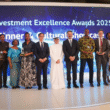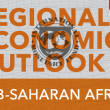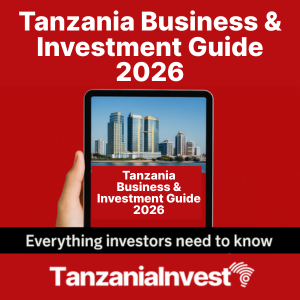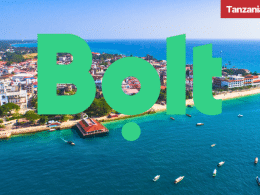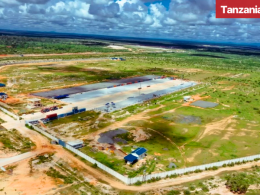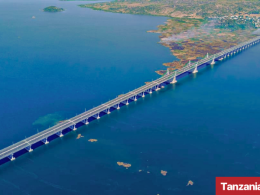TANZANIAINVEST has been interviewing Mr. Fred Addo Abedi, former Chief Executive of the Tanzania National Roads Agency (TANROADS), to learn about the Tanzania road infrastructure and about the role of its institution within such framework.
TI: What is the current situation of the Tanzania road infrastructure? Is it adequate enough to accompany the current Tanzania trade and exports, and the expected growth of the Tanzania economy?
Fred Addo Abedi – TANROADS: Well, as you said, roads are very essential for trade.
Roads are also very essential for poverty reduction, and for economic growth.
Tanzania has currently about 85,000 km of routes, out of which about 10,000 is regarded as trunk routes.
These trunk routes connect the capital city Dodoma to the regional capital, and also to the capitals of the neighbouring countries.
The regional road network represents the second tier.
There are about 20,000 km of these which connect the regional capitals to the district capitals.
Then you have the tertiary and fourth level of routes.
These are the district and community routes with about 55,000 km.{xtypo_quote_right} The administration of the roads is split between two ministries [but] road development should be done in a holistic manner.{/xtypo_quote_right}
The administration of the roads is split between two ministries, the Ministry of Infrastructure Development that looks after the main roads- which are the 10,000 km of trunk roads and 20,000 km of regional roads- and the Prime Minister’s office Ministry of Local Government (PORALG), that look after the tertiary and fourth level of roads- that is district roads, the filer roads, and the community roads.
But, road development should be done in a holistic manner because every hub only has main roads, which are not connected to the district roads and then you do not have the total effect.
We, as TANROADS, look after the main roads, as you have said, and that is our primary concern.
Our duty and commitment is to ensure that these roads are in as best condition as possible.
TI: Where does that commitment stand now?
FAA: Well, Tanzania has mixed traits.
About 10 years ago, the government realized that the road network was becoming a bottleneck to economic growth, poverty reduction, and promotion of trade, and [so they] instituted a lot of reforms in the road sector as a way of bringing road issues up to the level [that] was needed if economic growth was to be sustained.
TANROADS was born out of these reforms where the management of the road sector has to be looked at.
Another thing was the financing of roads in the country, especially the maintenance; otherwise you build the roads, they deteriorate and you have to build them again, and then you do not make a lot of progress.
TI: But where do you draw the line between building new kilometres of roads and maintaining the current ones in the Tanzania economy, which is struggling for infrastructure development?
FAA: {xtypo_quote_left} If new roads are built where they help for the development of the economy, they also generate money that will, in turn, finance their maintenance.{/xtypo_quote_left}I think the balance becomes much easier to define as your original investments are made properly.
If new roads are built where they help for the development of the economy, they also generate money that will, in turn, finance their maintenance.
On the other hand, we need to cater to everybody in the country by building roads which are not as important.
There is a need for a proper balance so that, in the first place, we build roads which are economical, which generate economic growth and money that can be made available for maintenance.
TI: Where do you find the balance at TANROADS? What is the current situation there?
FAA: Let me give you the statistics.
TANROADS is looking up to approximately 30,000 km of roads.
Only 5,000 of these are paved.
This is a bit too little.
So, I define this as an immature network and this is a problem.
When you have an extensive network of unpaved routes you have to attend to them much more regularly, and [especially when] you are using gravel, which is not inexhaustible.
So, the network is immature and I believe we need to increase the length of the paved network up to an optimum level where we would have a good balance between paved and unpaved roads.{xtypo_quote_right}There is a 10-year development program which is already ongoing.{/xtypo_quote_right}
That is why it is necessary to ensure that investments are made prudently so that we build, then upgrade the roads to between standard or become paved.
We have to look at the economic impact so that this can support economic growth which in turn generates more money, which can then be used for its maintenance.
For this, there is a 10-year development program which is already ongoing.
This has been integrated into the Transport Sector Investment Program (TSIP).
Outlook of the Tanzania Road Infrastructure
TI: Could you brief us on the main guidelines about this Tanzania road program?
FAA: {xtypo_quote_left}The 10-year sector development tries to achieve [the goal] that the entire country road network becomes paved.{/xtypo_quote_left}The 10-year road program started around 2002, when all the main roads had been ranked in respect to our internal rate of return.
In this ranking there were a lot of considerations, such as national integration, for example, but, of course, the most important thing is the economics.
The 10-year sector development tries to achieve [the goal] that the entire country road network becomes paved, or at least all those roads which are paramount to the economic development.
TI: Will all of this be achieved?
FAA: I do not think one can say that.
Definitely, it would be ideal to pave the entire trunk road network, which is about 10,000.
The idea is to achieve that by 2025 or thereabout.
If the entire trunk road network was paved and about 50% of the regional road network was paved for a total of about 20,000 km, it would be desirable and this is one of the targets that the government has set for itself.
Now the money required for that needs to be raised.
TI: Roads development tends not to be extremely interesting or profitable for private capital to come in and hence it is usually sustained by either government funds or by donors. What is your response to that?
FAA: To a large extent this is true, but I do not think any country thinks that they can build all the roads they need through the private sector.
What countries try to do is to find the roads that would be profitable for the private sector and let them out through various schemes, such as build-operate-transfer, and then the government looks after the other roads, which are still necessary.
But we also need a framework so that the people who would like to invest would know that, when they come to invest, they will be protected.
So, there is a process now to establish this framework.
TI: Has the government already identified the roads that could involve private capitals and be economically viable?
FAA: There are numbers of roads which people have talked about, of which I am not in a position to name any, but there is still the need for primary assessment.{xtypo_quote_right}If the government may have to repair a section of road, it can be let out to the private sector to maintain this for about 25 years and then given back to the government.{/xtypo_quote_right}
There is also quite some work that needs to be done to ensure that the traffic would be enough to attract full private sector participation.
We are talking about 10,000 vehicles per day and only few urban sections may generate such traffic in Tanzania.
I also mentioned full private sector participation because there are various variants.
For example, if the government may have to repair a section of road, it can be let out to the private sector to maintain this for about 25 years and then given back to the government where, through charging of tolls, they could maintain them and also have profit on the investment that they make.
Another option is to develop new roads where the government would put part of the equity.
Otherwise, the tolls will be so high for the traffic that uses the roads [it would] drive traffic out.
So, the government can buy equity in these to ensure that the tariffs would be reasonable and that the private sector companies involved will also have a reasonable return on whatever investment that they make.
TI: What part does TANROADS play in that?
FAA: Tanroads was set up in 2000.
We are a young organization.
One of the biggest objectives was to try and stabilize the network and I think in these years we have done something that we can all be proud of.
In 2001, we established that about 50% of the entire main network was in poor condition.
As we speak now, there is around 16% that is in poor condition.
There is still a lot to be done.
That is the next stage of our development.
TI: When do you think that 100% of the current main network will be in good condition?
FAA: We will try, but with the level of funding that we are getting now, this may not happen.
TANROADS has two sources of financing.
Directly from the government, we get money for development and for operating and also rehabilitation, but we receive only about 50% of what we need to correct the network.
Then, there is the Roads Fund, which derives its revenue from levy on the fuel and such revenues are used mainly for maintenance.
We get around 50 million US dollars a year from the Roads Fund for maintaining the national route network.
For this, the Roads Fund is looking at ways of broadening the base so that they can collect more revenues, but we also make representations through government to see if we can also receive some allocation for maintenance through the central government.
Having said all that, it is correct to say that the basic network is in place in this country at this stage.
TI: The Government of Tanzania (GOT) through the Ministry of Infrastructure Development has recently prepared a new massive 10-year infrastructure development plan. The plan is expected to be financed mainly by the international donor’s community in the amount of $5.5 billion for the first 5 years. The amount has been deemed too high by the donor’s community. What is your opinion on that?
FAA: Well, you can understand the hunger of this country for infrastructure.
Indeed, the donor’s community said that the amount requested should be realistic, and I think this has been done.
This was the first consultative meeting where Tanzania is trying to show our vision, where we would like to be.
So, over the next few months, there would be a number of discussions and consultations.
So yes, there is a gap between the donors and the Government of Tanzania, but this can be worked out and a realistic program would result.
I think within the next year we should see very clearly what we are able to do, where and from whom we are likely to get support and what kind of funds can be generated internally so that a robust and achievable program can be put in place.
TI: Such huge amount of money being sought seems to be justified by the requirement for the development of all means of transport. However, the biggest amount of money is expected to be diverted to roads. What is your opinion on that?
FAA: It is true.
For how much I was told that the county is looking at the holistic approach to developing transports and also to ensuring that there is the use of other means of transportation, which would take out some of these stress on the roads, looking at figures again we see roads mainly.
Let me put it in this way: the roads are very powerful in developing countries.{xtypo_quote_left}We have to look at building the other modes of transport where they compliment each other.{/xtypo_quote_left}
You do not hear about this that much in the developed world because there they have been built already.
But roads can make a lot of difference to any community that has a good access.
I have seen it in my life where communities have been transformed over a five year period because they had good roads.
In a number of places, roads are the only means of transport to access them.
I am not sure that, in an area where few thousand people live, [it would be] worthwhile to build an airport.
So, roads are the most cost effective way of providing access to communities.
Overall, I believe we have to look at building the other modes of transport where they compliment each other or they compliment the rural infrastructure.
So, there may be areas where it may be easier to have a medium-sized airport to compliment the current road network and not to compete with it.
Still, within such context I define the road infrastructure as the basic transport infrastructure.
TI: To conclude, from your perspective as a Ghanaian, what is your realistic forecast for the socio-economic development of Tanzania? Do you think everything is in place to guarantee the successful welcoming of foreign investors and to upgrade the level in Tanzania from that of a less developed country to more of a middle income level?
FAA: I count myself very fortunate to have worked in Ghana and also to have the opportunity to work in Tanzania.
These two countries are very similar in a number of ways. I can say I am happy from what I have seen.
Both countries are doing very well in terms of putting in place the structures that are necessary not only to attract foreign direct investment, but also to drive their countries in the manner where they can develop very quickly.
I live in Tanzania now and Tanzania has come a long way in putting in place good governance. {xtypo_quote_right}Tanzania has come a long way in putting in place good governance.{/xtypo_quote_right}
The public service has been restructured and these are the necessary things that will attract foreign investment and also help in the development of the country.
I think Tanzania is on the right track and, if you look at the support that Tanzania attracts from the development partners, it gives you an indication of the goodwill that Tanzania has.
You do not get the goodwill if you do not do things right.

